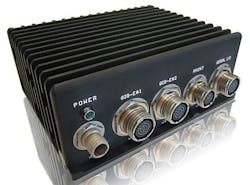Intel-based small-form-factor embedded computer for military uses offered by Kontron
The rugged small-form -factor system capitalizes on the company's hardened COM Express computer-on-modules (COMs) and Intel x86 processor architecture, company officials say. The Kontron COBALT is a fanless, enclosed system that measures 5.5 by 8.5 by 3.5 inches, and weighs less than 5.5 pounds.
The Kontron COBALT provides additional tightly-coupled mezzanine features, a ruggedized compact carrier board, and system interface board (SIB) that give customers increased I/O options.
Kontron designed the IP67 chassis to operate in extreme temperatures, shock, vibration and EMI. Powering the Kontron COBALT base system is a 3rd generation Intel dual core-based COM Express Type 6 module that has ECC, rapid shutdown design, and 100 percent extended temp screening with the option of removable or fixed solid-state disks or fixed mSATA storage.
Windows, Linux, and VxWorks operating system and software support packages also are available. The carrier board design make the most of the system's capabilities while minimizing its overall size and meeting higher temperature and shock and vibration conditions.
For more information contact Kontron online at www.kontron.com.
